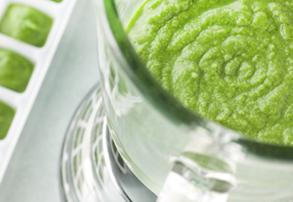Html code here! Replace this with any non empty text and that's it.
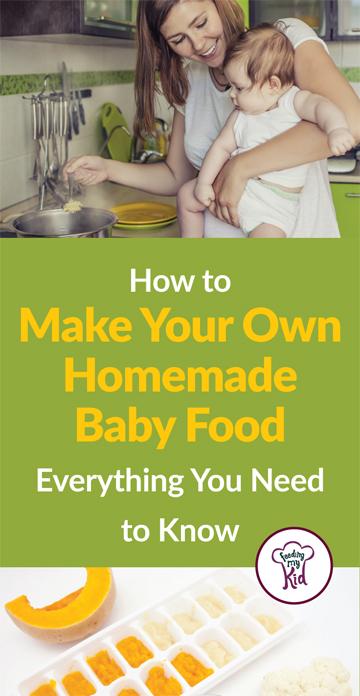 We have created a Baby Food Making Guide, which will walk you through all the steps necessary to start making delicious baby food for your little one. Plus, check out all the puree recipes created by parents just like you.
We have created a Baby Food Making Guide, which will walk you through all the steps necessary to start making delicious baby food for your little one. Plus, check out all the puree recipes created by parents just like you.
I really regret not making homemade baby food for my twins. Find out why.
There are a number of ways to make the whole baby food making process easier for you.
We highly recommend making a batch of purees and then taking a few servings out and freezing the rest to use later.
You can eventually start combining the different batches to make combinations of foods to offer your baby. Find out how to best freeze your baby food.
Check Out More Baby Food Recipes Here:
- Making It Easier for Moms! Delicious Baby Food Recipes
- 20 Homemade Baby Food Recipes Using Organic Ingredients
- Your Ultimate Guide to Making and Storing Baby Food. Healthier and Budget-Friendly!
Here Are Many Ways to Cook Baby Food Before Pureeing It: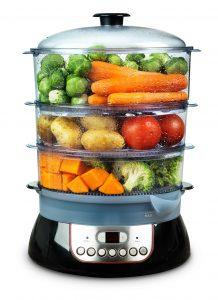
Steaming
This is generally the best way to preserve the most nutrients in the food along with baking/roasting. This goes for when you are making baby food and later one when you are making family dinners.
We’ve curated our favorite steaming tools in our Amazon store to make it easier for you to find.
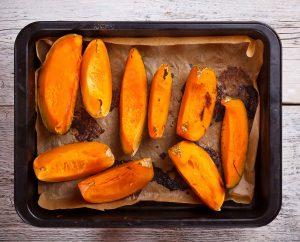 Oven Baking / Roasting
Oven Baking / Roasting
Along with steaming, roasting preserves the most nutrients and that’s the goal! You want to provide your baby and kids the most nutrients from food as possible.
You can lay the food out on a baking dish with a little oil.
Also, roasting veggies brings out the sweetness of the vegetables and breaks down the bitter taste, which will help your baby accept and learn to like to eat their vegetables.
We’ve curated our favorite tools in our Amazon store to make it easier for you to find. Unsure how to roast veggies? Check out this youtube video on how to roast veggies.
Stewing
Stewing is a great option for meats. You can make a meal in a crockpot or stew pot to break down the meat and other ingredients so it’s easy to puree and blend.
Here are some of our favorite crockpot recipes.
Boiling
You can boil the food in a little bit of water on the stove. Some nutrients will end up leaching out of your food into the water, so this isn’t the preferred method of cooking.
Do not pour the water out. You may need to add water or breast milk/formula to add some moisture back into the food to thin it out.
Pureeing /Mashing
 There are countless tools you can mash, from using a fork like this photo, to using hand blender (immersion blender), to a high power blender to a baby food maker to a food processor. I never used my immersion blender until having my twins, and now I use it every single day!
There are countless tools you can mash, from using a fork like this photo, to using hand blender (immersion blender), to a high power blender to a baby food maker to a food processor. I never used my immersion blender until having my twins, and now I use it every single day!
Some days, make it simple and just use a fork on foods like a banana, avocado, etc. There are a number of no cook baby food options. Remember to leave the lumps! Find out why. 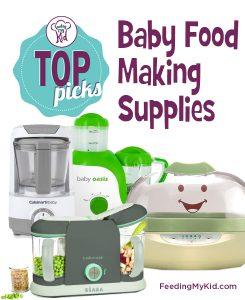
Now that you’ve made your own baby food, it’s time to puree it.
Our Favorite Baby Food Making Supplies
We’ve curated our favorite blending/pureeing tools for you in our Amazon store.
Consistency
Use the water that is left over from steaming or boiling your baby’s food, as the nutrients that leach out of the food will be in the water.
To thin out your baby food: You can also add more watery fruits and vegetables to your purees like a pear, apple, cucumber,or zucchini to add liquid to the puree combo to thin it out.
To thicken your baby food: Beans, potatoes, and butternut squash are a great thickening agent if your puree is too runny. You can also add some rice cereal to thicken it up.
The consistency of first purees, around 6 months, should be runny as your little one is just getting started. You can add expressed breast milk or formula to your puree to help thin out your baby’s first foods. It’s recommended to add formula or breast milk to thin out the consistency since your baby is already used to this flavor and it can help your baby accept the new foods being offered more readily.
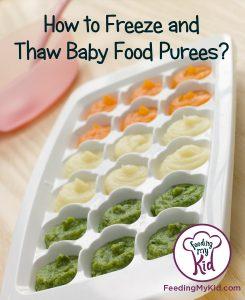 Find out how to store and freeze your baby food.
Find out how to store and freeze your baby food.
There Are Three Stages To Weaning Your Little One:
These are just estimates to help you understand what consistency you should offer your child at what recommended age. These are just guidelines. We highly recommend you start to wean your baby off purees by 10 months and have your baby eat more finger foods and the same table foods you are feeding your family. However, some kids are not able to handle textures.
Check out our ultimate guide on how to introduce solid foods. This is everything I wish someone had told me when I was introducing solid foods to my twins.
Also, check our feeding milestone article for more details by month.
Stage 1: (Up to 7 months)
Your baby is learning basic skills like taking food from the spoon by putting his lips around the spoon and then how to move food around his mouth. You can offer runny purees, thicker purees and mashed food like bananas, as soon as your baby will allow. Also, studies are showing the benefits of serving peanut butter, eggs and yogurt to your child early to help ward off future food allergies.
Stage 2: (7 – 9 months)
Your child is learning how to move textured food around in his mouth and learning how to chew lumps. No teeth are required! Start introducing a lot of variety of food to your child with lots of texture and lumps. You can also introduce a sippy cup. What if your child is gagging and/or throwing up?
Around 9 months old, babies start to develop their “pincer grip”. If you haven’t already, start giving your baby more opportunities to develop his pincer grip by offering dissolvable finger foods so he can practice picking things up. Consider weaning your baby off purees at this point.
Stage 3: (9 – 12 months)
Your child is learning to chew, even without teeth. He should be eating a larger variety of finger foods and harder textured foods. He should be eating finely chopped food or food with larger pieces. It’s still important to make sure you cut up your child’s food into age appropriate sizes or give larger, easy to handle pieces that your child can take a bite from.
Check out the article what’s normal eating for 9-12 months. It’s an informative article about everything happening from 9-12 months. Your baby should be enjoying three meals a day at this point. Your baby should also be mastering how to chew foods like ground beef.
If your child is struggling with textures and table food, please reach out to your Pediatrician to get an evaluation with an Occupational Therapist and/or Feeding Specialist. These specialists can provide you with exercises and tips on how to best help your child overcome your child’s possible feeding challenges. Also, see our article about understanding feeding issues to learn more about the different kinds of feeding issues that can happen. I couldn’t be a bigger advocate for early feeding intervention. If you are concerned seek a Feeding Specialist for an evaluation.
Subscribe to our Youtube Channel for our video series about how to best feed your baby, toddler, and school-aged child.
Share your thoughts below.


